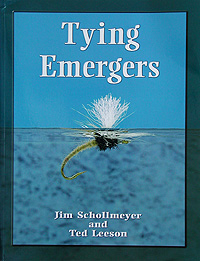I spent time today taking advantage of a fresh batch of quality CDC. It is a joy to use and makes it easier if you use quality CDC - from Marc Petitgean.Good, but expensive. I have tied some CDC bubble style emergers. Winterbourne in his blog has tied a lovely CDC comparadun which should be checked out. Looking forward to using these next season in both the river and the lake.

Dressing:
Hook: Fine wire scud hook, Size 14-18.
Shuck: Krstalflash
Body: Turkey Boit or superfine dubbing
Wing: Dun CDC (tied bubble style)
Thorax: Hare's ear (colour to suit abdomen)
Obviously the styles for adopting CDC in emerger patterns are numerous. Here are several more.
Shuck: Dun CDC fibres
Body: black thread
Rib: gold wire
Wing case: Dun CDC
Thorax: Peacock herl
Hackle: Grizzle
The next pattern is a generic emerger pattern that can be used to represent a variety of hatches. As with many emerger patterns, it is a 'quick tie' as Oliver Edwards would say, and very easy to throw a batch up quickly.
Shuck: Mirage krstyalflash (two strands)
Body: Turkey Boit
Wing: Light Dun CDC
Thorax: Rabbit or Hare's ear to match body
Check out Dave Whiltshire's fly page on the Dancia fly tying site for some lovely CDC styled emergers,
http://www.danica.com/FLYTIER/dwiltshire/dwiltshire.htm .I really like his crippled emergers - sleek, slim and deadly looking. Another tyer deomonstrating the use CDC for all sorts of flies is Gianluca Nocentini.
http://www.danica.com/FLYTIER/gnocentini/gnocentini.htm.
























